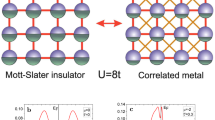Abstract:
We study the Cu5O4 cluster by exact diagonalization of a three-band Hubbard model and show that bound electron or hole pairs are obtained at appropriate fillings, and produce superconducting flux quantization. The results extend earlier cluster studies and illustrate a canonical transformation approach to pairing that we have developed recently for the full plane. The quasiparticles that in the many-body problem behave like Cooper pairs are W =0 pairs, that is, two-hole eigenstates of the Hubbard Hamiltonian with vanishing on-site repulsion. The cluster allows W =0 pairs of d symmetry, due to a spin fluctuation, and ssymmetry, due to a charge fluctuation. Flux quantization is shown to be a manifestation of symmetry properties that hold for clusters of arbitrary size.
Similar content being viewed by others
Author information
Authors and Affiliations
Additional information
Received 23 July 1999
Rights and permissions
About this article
Cite this article
Cini, M., Balzarotti, A. & Stefanucci, G. Pairing in the Hubbard model: the Cu O cluster versus the Cu-O plane. Eur. Phys. J. B 14, 269–280 (2000). https://doi.org/10.1007/s100510050129
Issue Date:
DOI: https://doi.org/10.1007/s100510050129



